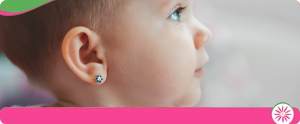Ear Piercing for Kids: Why a Pediatrician Should Do It Q&A
Ear piercing for kids should ideally be performed by a pediatrician due to their medical expertise and understanding of child-specific safety protocols, minimizing the risk of complications. Pediatricians can ensure a hygienic and sterile environment, prioritize the child’s comfort, and offer proper aftercare guidance to promote optimal healing. Dr. Julia Barriga, MD, P.A, provides ear piercing for your infants in a hygienic, secure, and supportive setting. For more information, contact us today or book an appointment online. We are conveniently located at 5001 East Busch Blvd Tampa, FL 33617.


Table of Contents:
Why do pediatricians pierce babies’ ears?
Why is it important for kids to get their ears pierced?
At what age should a kid get their ears pierced?
What to expect after getting ears pierced for kids?
Pediatricians can perform ear piercings on children and ensure the procedure is done in a clean environment, using single-use, sterile equipment to minimize the risk of infection. This is crucial for babies in particular, as they are more susceptible to infections and complications.
Unlike mall kiosks or jewelry stores, medical professionals follow stringent hygiene protocols to protect the health of the child during the piercing process. Seeing a pediatrician to have your child’s ears pierced can prevent a variety of complications, such as irritation, keloid formation, infections, allergic reactions, and other issues.
In addition, to minimize pain and discomfort, pediatricians often use topical anesthetic creams to numb the earlobes before piercing. This step makes the procedure virtually painless for the baby, reducing stress for both the child and the caregivers. After the piercing, the pediatrician will provide detailed aftercare instructions and follow-up support, including guidance on how to clean the piercings properly and what signs of infection to watch for.
Piercing your child’s ears at a young age can provide advantages such as faster healing. Babies’ skin tends to heal more quickly than that of older children or adults. Additionally, babies are less likely to touch or play with their piercings, which reduces the risk of infection.
For many families, piercing a baby’s ears is a cultural tradition or a way to honor familial customs. Pediatricians can perform the procedure in a way that respects these traditions while ensuring the highest standards of medical care and safety.
The decision of when to pierce a child’s ears is ultimately up to the parents, but there are several things to think about that might aid in choosing the appropriate moment. A lot of parents decide to pierce their child’s ears during infancy. One advantage of piercing an infant’s ears is that babies are less likely to fiddle with their earrings. However, parents must be diligent about following aftercare instructions to prevent any complications.
On the other hand, other parents choose to wait until their child is older and can participate in the aftercare process. Regardless of age, it’s crucial to have the ear piercing done in a sterile environment by a professional. Pediatricians can handle the delicate nature of piercing a child’s ears and provide detailed aftercare instructions to ensure smooth healing.
To summarize, the best age for ear piercing depends on the parents’ preferences and the child’s readiness. It’s important to ensure that your child if they are old enough to understand, is comfortable with the idea and willing to cooperate with the aftercare routine.
After getting your child’s ears pierced, proper aftercare is crucial. Right after the piercing, the area may be slightly red, swollen, or sore. This is common and will get better in a few hours to a couple of days. It’s important to ensure that your child keeps their hands clean and avoids touching the new piercings.
You should clean the pierced area twice daily with a saline solution or an antiseptic provided by the piercing professional. It’s recommended to use a cotton swab to gently clean around the earring and the ear lobe. To avoid irritating the skin and delaying healing, avoid using hydrogen peroxide or alcohol to clean the piercing.
To minimize the risk of infection, do not remove the earrings for at least six weeks. Your child should avoid swimming in pools, lakes, or hot tubs during the initial healing period, as these can harbor bacteria. After the initial six weeks, the earrings can be removed and changed. However, it’s advised to wear earrings continuously for the first half of a year to keep the gaps from closing. If your child reports discomfort beyond the initial days, you should watch for signs of infection and consult our experienced pediatrician. For more information, contact us today or book an appointment online. We are conveniently located at 5001 East Busch Blvd Tampa, FL 33617. We serve patients from Tampa FL, Terrace FL, Thonotosassa FL, Lutz FL, Greater Carrollwood FL, Lake Magdalene FL, Westchase FL, Town ‘N’ Country FL, and surrounding areas.

Additional Services We Offer
- Dental Fluoride Varnish
- Newborn Care
- Vaccines/Immunizations
- Health Education & Counseling
- Physical Examinations
- Hearing & Vision Screening
- Management of Chronic Conditions
- Comprehensive Well Visits
- Asthma Management
- Diabetes Management
- ADD/ADHD Management
- Diagnostic Services
- Ear Piercing
- Prenatal Consults
- In House Lab Testing
- Get Acquainted Consults
- Covid Testing
- Flu Testing
- RSV Testing








